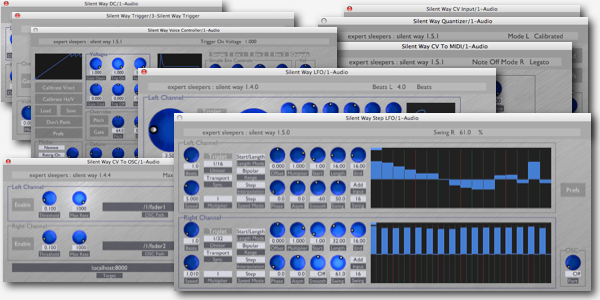In A Silent Way
When I first heard of Silent Way — a plugin suite written by Os from Expert Sleepers — my first thought came to a song performed by Weather Report. The lead keyboardist, Joe Zawinul, was well known for his use of the ARP 2600. He used to have two of them, with one having the keys order inverted so he could play low and high notes together on both keyboards.

Silent Way is a suite of plug-ins designed for use as part of a modular analogue synthesiser system. The plug-ins produce no sound themselves, nor do they process sound – rather, they generate signals to be used as control voltages (CVs), which can be patched into the control inputs of oscillators, filters, VCAs etc. of an analogue system. Also, with the addition of the CV Input plug-in, it is possible to bring CVs from the synth into the computer, for recording or processing.
With this in mind the relationship to Weather Report’s song became even clearer in my mind. Joe Zawinul was a notable innovator, thus naming a plugin after a song he wrote for Miles Davis in 1969 was certainly appropriate. My interpretation has changed though, I understand the name reflects the fact that these plugins are just “silent”.
Using Analog Modular Synths is not always easy or convenient. First, you have to deal with calibration and fine tuning of the parameters. You have to consider that temperature can affect your settings, so playing them on stage is not really obvious. Also, there’s not a lot of solutions when it comes to using them along with modern setups involving a sequencer, plugins, MIDI or OSC.
Typically you would use a CV to MIDI converter, but then loose a lot of information because MIDI’s limited data range. With some tweaking you would be certainly able to play sequences with the CV/MIDI converter, but it is not straightforward as some careful calibration is still needed.
Nonetheless, even with these limitations, modular synths are still designed, produced and used. There are even pieces of music written exclusively for modular synths. So, what makes them so appealing when you know difficult they are to use?
According to some people, their organic and raw response still surpasses digital signal processing based systems. But it’s not only that: there is a lot of plugins and digital workstation that sound great.
Really, I think their power lies in the ability to tweak them, turn the buttons, patch some cords, do this all in “real”.
It’s like using an analog mixer desk, instead of mixing with the mouse in Pro-Tools. I like this analogy very much, because it gives a good understanding of how things are evolving today: we want analog mixers, but drive them with a digital audio workstation. We want software plugins, but also keep the possibility of using an old Roland Tape Echo device, guitar pedals, EMT reverbs, and use all of them together — with automations. (to some extent, it’s like shooting pictures on film, and scan them on a film scanner without even making prints)
Silent Way helps this analog and digital cohabitation go further thanks to its automatic calibration and tuning features. If you own a compatible audio interface, the CV/MIDI converter is not needed anymore, and the computer takes control of your modular synth, exposing its rich features to your digital audio workstation.
Silent Way works both ways, your computer can control a modular synth, and a modular synth can control your computer. On his blog, Navs talks about his setup involving a Moon Modular sequencer and Logic running a virtual instrument. In his post, he shows a beautiful sequence generated by the synth which is plugged into his audio interface, acting as a soft CV bridge thank to Silent Way, then into OSCulator to process the OSC messages, and finally into Logic where the virtual instrument is hosted.
